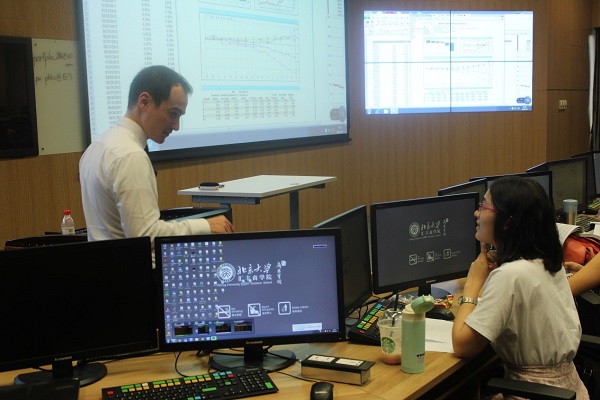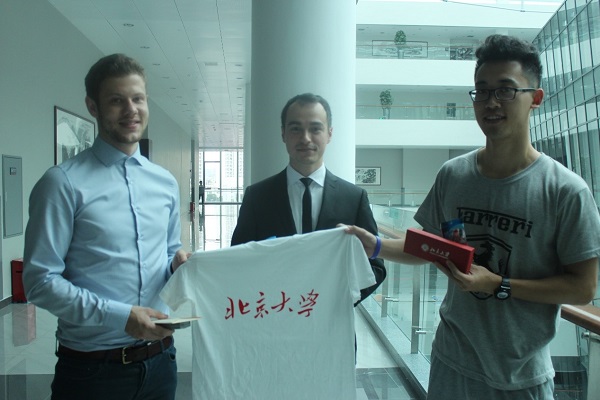【PHBSSU】“股权市场量化投资策略”工作坊圆满开展
5月7日至5月8日,由学生会主办,互联网金融协会协办的为期两天的关于量化投资策略的讲座顺利开展。主讲人Michael Nuske以从业人员的视角探究了股权市场中的量化投资策略,讲授之余,Michael还和同学们面对面交流了实际的工作经验和在德国的生活经历。
Michael Nuske,CFA,现任德国贝伦贝格银行全球股票投资组合经理,2009年本科毕业于伦敦政经商学院,2010年获得华威大学的经济金融的硕士学位,目前致力于投资要素和ESG投资的研究。
此次课程主要为大家介绍了量化研究和股权市场分析的方法。同学们不仅学习了股权模型选择的注意事项,包括统计推断,可行性分析以及现实生活中对其的权衡,还通过小组完成Excel和Bloomberg的简单动态单因素模型,对课程中介绍过的分析工具进行了实操练习。
1. Introduction: My job as a portfolio manager at Berenberg
Summary: This is a brief introduction of where I come from and what my daily work in the institutional asset management division is like.
Outline:
Who are we?
What is our business model?
What services do we offer?
Our investment process
2. Quantitative research and analysis for equity portfolio management
Summary: How to build a rule-based equity selection model? This topic starts off reviewing different methods in quantitative portfolio management, followed by highlighting important considerations when constructing selection models with real-life examples.
Outline:
Difference to traditional discretionary stock selection
What methods are there in general? (technical analysis, fundamental analysis, machine learning)
How to construct a quantitative equity selection model? (including considerations related to economic reasoning, data quality, significance testing, data mining, over-fitting)
Real-life examples using FactSet, Bloomberg, and Excel
3. “Factor Investing” as evidence of quantitative stock selection becoming mainstream
Summary: Over the last few years there has been a strong trend in the active asset management industry towards factor investing. This topic will shed some light on the reasons behind this trend and illustrate current developments.
Outline:
Introduction and rationale behind this trend
Most talked about factors (momentum, value, size, dividend yield, quality, low volatility)
Current developments including new products created by the financial services industry (e.g. ETFs tracking momentum-weighted indices)
Factor explanatory power testing including back tests
Factor attribution via multivariate regression analysis in Bloomberg
4. Building a proprietary model and testing it
Summary: Students are required to create a strategy based on one particular factor of their own choice. This will be done in Excel, utilizing the Bloomberg API to make the model dynamic and easily updatable in the future. Analysis of the strategy will focus on back testing and applying techniques introduced in previous sessions.
Outline:
Introduction to data vendors like Bloomberg and FactSet
How to use them?
Using the API to pull data from Bloomberg via Excel (with assignments)
Useful Excel shortcuts to increase efficiency
Building and analyzing the model
5. Final Q&A
Summary: Students are encouraged to ask anything they like about financial markets or myself. I will provide real-life experiences from Asset Management, Investment Banking, and Private Banking to give students ideas about what to expect when choosing different careers in finance.
图一

图二

图三

图四

图五

图六
Michael Nuske,CFA,现任德国贝伦贝格银行全球股票投资组合经理,2009年本科毕业于伦敦政经商学院,2010年获得华威大学的经济金融的硕士学位,目前致力于投资要素和ESG投资的研究。
此次课程主要为大家介绍了量化研究和股权市场分析的方法。同学们不仅学习了股权模型选择的注意事项,包括统计推断,可行性分析以及现实生活中对其的权衡,还通过小组完成Excel和Bloomberg的简单动态单因素模型,对课程中介绍过的分析工具进行了实操练习。
课程大纲
Topics, teaching, and assessment schedule1. Introduction: My job as a portfolio manager at Berenberg
Summary: This is a brief introduction of where I come from and what my daily work in the institutional asset management division is like.
Outline:
Who are we?
What is our business model?
What services do we offer?
Our investment process
2. Quantitative research and analysis for equity portfolio management
Summary: How to build a rule-based equity selection model? This topic starts off reviewing different methods in quantitative portfolio management, followed by highlighting important considerations when constructing selection models with real-life examples.
Outline:
Difference to traditional discretionary stock selection
What methods are there in general? (technical analysis, fundamental analysis, machine learning)
How to construct a quantitative equity selection model? (including considerations related to economic reasoning, data quality, significance testing, data mining, over-fitting)
Real-life examples using FactSet, Bloomberg, and Excel
3. “Factor Investing” as evidence of quantitative stock selection becoming mainstream
Summary: Over the last few years there has been a strong trend in the active asset management industry towards factor investing. This topic will shed some light on the reasons behind this trend and illustrate current developments.
Outline:
Introduction and rationale behind this trend
Most talked about factors (momentum, value, size, dividend yield, quality, low volatility)
Current developments including new products created by the financial services industry (e.g. ETFs tracking momentum-weighted indices)
Factor explanatory power testing including back tests
Factor attribution via multivariate regression analysis in Bloomberg
4. Building a proprietary model and testing it
Summary: Students are required to create a strategy based on one particular factor of their own choice. This will be done in Excel, utilizing the Bloomberg API to make the model dynamic and easily updatable in the future. Analysis of the strategy will focus on back testing and applying techniques introduced in previous sessions.
Outline:
Introduction to data vendors like Bloomberg and FactSet
How to use them?
Using the API to pull data from Bloomberg via Excel (with assignments)
Useful Excel shortcuts to increase efficiency
Building and analyzing the model
5. Final Q&A
Summary: Students are encouraged to ask anything they like about financial markets or myself. I will provide real-life experiences from Asset Management, Investment Banking, and Private Banking to give students ideas about what to expect when choosing different careers in finance.

图一

图二

图三

图四

图五

图六
(供稿:北京大学汇丰商学院学生会PHBSSU)





